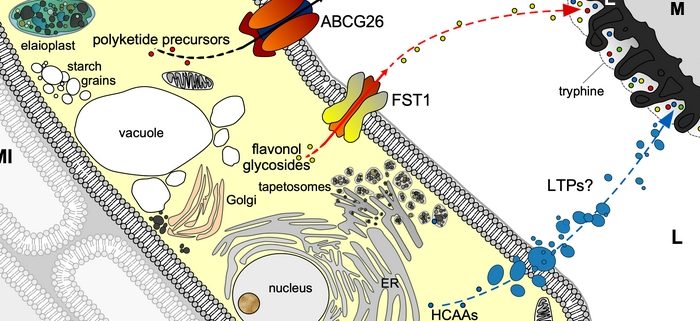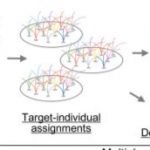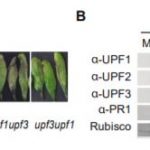Pollen surface replenished: a tapetal flavonoid transporter
Grunewald et al. identify a flavonoid transporter required for the deposition of flavonol-b-1,2-linked diglycosides to the outer pollen wall in Arabidopsis thaliana. The Plant Cell (2020) https://doi.org/10.1105/tpc.19.00801
By Stephan Grunewald and Thomas Vogt, Leibniz Institute of Plant Biochemistry, Dept. Cell and Metabolic Biology, D-06120 Halle
Background: The rigid pollen wall of all flowering plants is usually covered by a complex mix of small molecules, termed the pollenkitt or tryphine. This blend of sugars, waxes, peptides, and different phenolics, specifically flavonoids, serves to attract pollinators. It also protects mature pollen grains from pathogens and various abiotic stresses, including drought, heat, or light stress. To ensure the integrity of the outer pollen wall, individual compounds are translocated in a highly controlled process from the tapetum to the outer pollen wall. In the case of flavonoids and other phenolic metabolites, the identification of a transporter has remained elusive.
Question: How are flavonoid glycosides translocated to the pollen surface? Is there a single or several transporters essential for the deposition of specific types of flavonoids and phenolics to the pollen wall?
Findings: We analyzed a series of wild-type and mutant Arabidopsis plants for differences in the accumulation of flavonoid glycosides and hydroxycinnamic acid amides (HCAAs) on the pollen surface by various analytical tools. A mutant in a gene encoding a nitrate/peptide transporter, NPF2.8, showed a drastic and specific reduction of the two flavonoid glycosides detected on the pollen surface. We have renamed this gene FST1 for Flavonol Sophoroside Transporter. All other metabolites, including HCAAs, were not affected. Pollen from greenhouse-grown mutant plants was completely normal for both germination and viability. The gene encoding NPF2.8 was expressed specifically in anthers and the transporter localized to the plasma membrane of the tapetum. Functional complementation of the mutant and transport assays performed in a microbial system corroborates that NPF2.8 is required for the accumulation of flavonoid glycosides on the pollen surface.
Next steps: Are orthologous transporters active in various angiosperms families? In the future, an examination of transporter specificity and the potential role of their substrates in plant fecundity and stress tolerance will be investigated.
Grunewald, et al. (2020). The Tapetal Major Facilitator NPF2.8 is Required for Accumulation of Flavonol Glycosides on the Pollen Surface in Arabidopsis thaliana. Plant Cell DOI: https://doi.org/10.1105/tpc.19.00801




